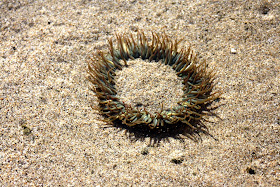Sarah had a bit of a spill on the way down to the beach - in one gulley there was a thin layer of sand overlying (and hiding) a thicker layer of mud, which she jumped down onto from a log.
A Clinocardium cockle peeking out from the sand.
A pretty fragment of bull kelp sitting on the beach.
Several years ago I spotted this huge thing weathering out of the cliff about 25 feet above the beach. I got a better photograph of it in the field, and finally figured out what it is. I always knew it was some sort of a huge cetacean skull, probably baleen whale, but couldn't make heads or tails out of its shape.
Here's a marked up version of the photo. This clearly shows that it's the posterior end of an upside-down baleen whale braincase- likely a balaenopterid whale - poking out, with some of the left braincase broken away and missing. The condyles, foramen magnum, right exoccipital, and even a tympanic bulla are evident. Judging from how far up this is, the skull is well over a meter wide, putting it somewhere in the size range of a Sei whale (Balaenoptera borealis). This specimen is a bit of a heartbreaker, because it would be impractical - if not impossible - to safely collect. People have seen this photo and suggested ropes, scaffolding, jackhammers, and all sorts of wild ideas but the simple truth is 1) digging that far in would likely trigger a cliff collapse and 2) far more easily collectable specimens are waiting to be collected on other beaches, without the need of all sorts of equipment I don't have the training or funding to operate.
This hole was dug five years ago by my field assistant/fossil buddy Chris Pirrone (attorney at law), and yielded a beautiful little "river" dolphin skull with a partial rostrum, mandible, and left and right tympanoperiotics which I referred to Parapontoporia sternbergi in my 2013 Geodiversitas paper.
Gooseneck barnacles and a single mussel poking out.
A piddock clam whose rocky home is being eroded more quickly than it can bore, beautifully showing how it forms boreholes.
A large green anemone lightly dusted with sand from the last high tide, within a shallow sandy tidepool.
View of the dramatic cliffs of Purisima Formation at the northern side of Tunitas Beach - one of the most scenic beaches in Halfmoon Bay, if not also one of the dirtiest; it's difficult to get to, and most people who go there to have barbecues and drink leave all of their trash in kind of a big heap at the bottom of the trail.
Stay classy, Halfmoon Bay.
Vertebrate fossils here are rare - this was my first discovery - a couple of associated dolphin vertebrae. The rock was far too hard to even think about removing them.
Invertebrates are not rare, however, and clusters of the slipper shell Crepidula princeps are quite common, such as this rather nice example.
The Purisima Formation here reflects deeper shelf sedimentation, and the traces can be quite large; here's a medium-sized Teichichnus trace. Elsewhere in the Purisima Formation Teichichnus traces can exceed 1 meter diameter (!) and approach 2 meters (!!!).
Here's a thalassinidean shrimp claw, complete with the dactyl and chela.
My wife hard on the search for fossils.

















No comments:
Post a Comment